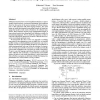156 search results - page 11 / 32 » An Abort-Aware Model of Transactional Programming |
ACMMSP
2006
ACM
14 years 1 months ago
2006
ACM
Many people have proposed adding transactions, or atomic blocks, to type-safe high-level programming languages. However, researchers have not considered the semantics of transacti...
MIDDLEWARE
2001
Springer
14 years 5 days ago
2001
Springer
Although it has long been realised that ACID transactions by themselves are not adequate for structuring long-lived applications and much research work has been done on developing...
ICDE
2010
IEEE
13 years 8 months ago
2010
IEEE
A way to optimize performance of relational row store databases is to reduce the row widths by vertically partitioning tables into table fractions in order to minimize the number ...
POPL
2008
ACM
14 years 8 months ago
2008
ACM
Software transactions have received significant attention as a way to simplify shared-memory concurrent programming, but insufficient focus has been given to the precise meaning o...
ISCA
2005
IEEE
14 years 1 months ago
2005
IEEE
Writing concurrent programs is difficult because of the complexity of ensuring proper synchronization. Conventional lock-based synchronization suffers from wellknown limitations, ...

